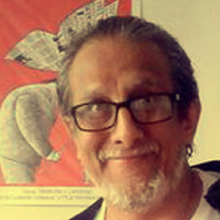Adoro el trazo suelto, espontáneo, humano e imperfecto como mi propia vida
Me fascina Perú por: Machu Pichu, el Cuzco, el Camino del Inca, la selva, su gran Historia precolombina, la Lima Colonial, sus valsesitos, su literatura, ¡su gastronomía! Y por supuesto, su gente. Pero no fue por nada de lo anterior que escogí a este artista para “dialocar” hoy. Lo hice por su talento, su sentido del humor, su personalidad, su humildad, sencillez y su sincera amistad. Confieso que siento tremendo placer y orgullo entrevistar al multipremiado humorista gráfico peruano, Karry Carrión.
Y sin más introducción, paso a las preguntas…
PP: Querido, amigo, ¿puedes presentarte tú mismo, por si existiera un lector de Humor Sapiens que no te conociera?
KARRY: Soy un humorista gráfico, historietista y gestor cultural. Nací en Lima, Perú. El amor por el arte y la música clásica es por mi padre. La picardía, el humor, la joda, por mi madre. Me independicé a los 19 años. Me fue imposible estudiar en una escuela de arte. Aprendí solo y encerrado entre libros de humor y revistas de comics, sumergido en la búsqueda y el descubrimiento de mi pasión por el humor gráfico, por las historietas. Soy autodidacta. Mi mejor escuela fue publicar y publicar sin parar en los medios más populares de alta lectoría. Desde los años 80 he publicado en 15 periódicos y revistas de humor, bajo los seudónimos: “Carr”, “Carrión”, “Julán”. Hubo tiempos en que las circunstancias me obligaban a dibujar para 4 periódicos a la vez con diferentes firmas y estilos. ¡Disfrutaba esa bendita locura!
En los años 90 nace “Karry” para el Perú y el mundo. Gracias a las tiras cómicas más emblemáticas de mi historia gráfica: “Simeón” y “La Combi Asesina”, logre cierta celebridad y una decidida posición en este difícil mercado, manejando dos lenguajes: uno universal (sin palabras) y otro lenguaje popular localista (con textos).
Adoro el trazo suelto, espontáneo, humano e imperfecto como mi propia vida. Me divierto buscándole la ironía a las situaciones, para provocar, emocionar, denunciar, reflexionar o simplemente divertir.
Desde el 2005 he sido galardonado con más de 80 premios nacionales e internacionales, He editado más de 15 publicaciones propias. En el 2021 trabaje para la Red Bull y para la UNESCO-Francia. Soy director de la revista Trimestral satírica “Monaliza”.
La familia va de la mano. Mi esposa es una gran aliada. Ella también hace arte y emprendimos juntos la escuela de humor y caricatura “Karry Studios. Para dinamizar y divulgar el arte del humor y la caricatura, formamos y creamos el colectivo artístico “Mochi Comic”. Para variar, dirijo la editorial ISPEKA EDICIONES. Me muevo mucho en Ferias, me encanta la adrenalina de las activaciones artísticas. Hice del humor una forma de vida y una profesión.
PP: Excelente autoretrato, Karry. Si el objetivo era conocerte, ya podemos terminar la entrevista aquí, ja, ja. Pero, no. Quiero que nuestros lectores sepan más de ti, más allá de tu autobiografía. Por ejemplo: ¿has variado, has evolucionado, tu forma de hacer humor, desde tus inicios hasta este momento?
KARRY: Sospecho que sí, hermano. Si antes lo hacía todo rápido, por instinto, ahora pienso más en los cambios de conceptos, tanto en forma como en contenidos.
A partir del año 2005, mis Haikús poderosos de arte y humor cruzaron fronteras, empezaron a obtener premios, reconocimientos. Comenzaron a llegarme invitaciones como jurado a concursos internacionales. Así como también fui invitado en varias exhibiciones colectivas internacionales. Todo eso nutre, amigo mío.
Sospecho que hubo una evolución. Para ilustrarlo destaco un comentario publicado en uno de mis libros. Me refiero a las palabras del maestro Juan Acevedo, uno de los más importantes estudiosos del humor y de la historieta peruana, que lo resume todo en una: Karry es un humorista gráfico muy peculiar, que ha sabido nutrirse del humor de nuestras calles y elevarlo a una dimensión universal, uniendo la savia popular y la elitista.
PP: Yo no tengo dudas de eso, hermano. Pero me gustaría saber: ¿crees que tienes influencia definida, clara, de colegas vivos o históricos?
KARRY: Mi primera influencia seria mi padre. El color, el arte, ya estaba en mi ADN. Mi padre, “Julkar”, fue un pintor surrealista, egresado de la Escuela de Bellas artes. Un loco de las formas y lo absurdo.
Te cuento que en los años 80 me entro la onda de ser Historietista de humor, de aventuras infantiles. Quería ser un Uderzo, un Willy Eisner, pero de leyendas peruanas, como mis coterráneos Crose o Hernán Bartra.
Luego en los años 90, mis referentes eran: Quino, Mordillo, Caloi, Sempé, Steiberg, Palomo…
Cuando decidí dedicarme al humor gráfico por entero, algunos colegas decían que el Perú perdió un gran Historietista de aventuras de humor. jejejejee… ¡Cosa que no me la creo!
PP: Pues yo sí me lo creo. Entonces, ¿te sientes feliz y realizado con tu carrera en el humor, con tantísimos premios? ¿Qué sientes saber que eres uno de los más reconocidos humoristas gráficos peruanos de todos los tiempos? (Te conozco y sé que no eres soberbio ni autosuficiente, pero tampoco seas muy modesto ahora, por favor).
KARRY: No voy a negarte que soy dichoso y muy honrado de trascender con mis cartones humorísticos en el mundo. El ego siempre lo he tenido detrás de mis trabajos. Los premios no son para mi sino para mis viñetas, que son consecuencias de un proceso afortunado en ideas y dibujo. El hecho de ser elegido entre miles de cartoons por un jurado internacional, es emocionante. Pero lo más rico es el abrazo de la familia y de los colegas cuando ganas uno importante. Con los pasos de los años entendí que cuando amas algo de verdad y le das todo tu tiempo y dedicación, como si fuera tu novia, al final eres correspondido.
PP: Tu esposa debe estar celosa de esta novia, ¿no? No, claro que no. Ya me dijiste que te acompaña siempre en tus "locuras" y además, es artista también. Pero continúo. Mira, tú te has especializado en viñetas editoriales y en humor general. ¿Cuál te es más difícil de hacer? ¿Con cuál de ellos disfrutas más en tu creación? ¿Cuáles son las diferencias entre ambas?
KARRY: Mi producción gráfica se sustenta en dos pilares: el humor mudo y el humor con texto. He escuchado decir que hacer humor mudo es más difícil, pues para mí se me hace fácil. Disfruto la libertad de generar humor sin palabras en todos sus géneros, me divierto más. Especialmente para los concursos, exploro, cambio de estilos, de conceptos, juego mucho con lo absurdo visualmente.
En cambio con los cartones editoriales del día a día me siento encasillado, me autocensuro por ajustarme al contexto periodístico. Toco todos los temas de actualidad socio política. Son muchos años dentro del periodismo nacional reflejando la época. Desde los años 80, imagínate. Actualmente público en el “Trome”, el periódico más vendido de Iberoamérica. Por eso tienes que pensar bien lo que vas a opinar. Mi columna tiene que conectar con la gente y me funciona, porque conozco el habla y los códigos de los barrios más populares. Desde muy adolescente fui un “pata de perro”, nací en un barrio muy criollo de Lima: “El palomar”. Gente con harta chispa, jergas y todo su “recuteco” de sabor nacional. Las calles me hizo humorista.
La diferencia es que las viñetas editoriales tienen una caducidad, cuando la notica muere, muere el chiste. Mientras que el Humor general y atemporal, ¡dura siempre!
PP: Te confieso que me encantó leer la palabra “recuteco”. No conocía ese peruanismo. Lo “googleé” y vi que era: “individuo que tiene experiencia callejera, esquina, experiencia de vida". Exactamente lo que nos contabas. Ahora yo también me defino como recuteco. Pero saliéndonos de ese4 tema, dime, ¿cuál ha sido el mejor y el peor momento en tu carrera dentro del humor?
KARRY: El mejor momento fue traspasar las fronteras y publicar en plataformas especializadas como “Cartooning for Peace” (Francia), en “Cartoon Movemente” (Holanda), “Toonpool.com” (Alemania), “Club de la caricatura latina” (México) y ser representante de Perú, invitado por Union of World Cartoonist (Turquía).
Los peores momentos fueron las censuras en los años 2006 y 2007. Tuve que renunciar a un periódico donde laboraba desde los años 90.
Te cuento que tenía una sección “Karrycaturas”, de humor general. Varias de esas viñetas fueron premiadas años después. Pero, lamentablemente, cambiaron de director y me pidieron… ¡que mi sección “Karrycaturas” fuera política!
Bueno, cambié de giro y desenvainé mi pluma criticando al gobierno de turno, al de Alan García. Y pasó lo que tenía que pasar. Los editores eran partidarios de ese gobierno y me aseguraron que solo publicarían un “humor de franela” al gobierno Aprista. Fue una decisión miope del director de aquel entonces. Tuve que irme del periódico que era como mi familia. Me brindaron todo para desarrollar mi lenguaje propio durante 18 años. Eternamente agradecido con los dueños. Ahí nació el seudónimo de “Karry”.
PP: Me alegro de tus buenos momentos, pero me enojan esas cosas extra artísticas que nos dificultan nuestros caminos como creadores. Pero voy ahora con varias preguntas en una: ¿cómo ves la salud del humor gráfico en la actualidad? ¿Hay suficientes espacios para publicar? ¿Lo que se publica es casi siempre de buena calidad? ¿Ve mucha diferencia entre el humor creado para los concursos y el resto? ¿Hay suficiente público consumidor?
KARRY: Lamentablemente, hay pocos espacios en los medios impresos para desarrollarse y vivir del humor. Pero tenemos la maravilla del internet, especialmente para los nuevos talentos, dónde pueden mostrarse sin restricciones. Claro, no siempre lo que se ve es bueno. A algunos les falta el oficio que dan los años. Las redes sociales han ayudado mucho a que el humor gráfico tenga más visibilidad. Pero cobrar y vivir por lo que subas a tus redes, sigue siendo el interminable rompecabezas.
El humor para los concursos tiene que tener un cien por ciento de originalidad y de gran factura, mientras que una viñeta editorial su tratamiento es diferente, pero sin perder calidad. Los editores no pueden ser tan ciegos. Estamos en una época totalmente visual, deben reconocer la función del humor como catalizador de nuestra sociedad, y que vuelva adquirir ese protagonismo que siempre tuvo. Sería genial que aparezcan nuevas publicaciones para captar nuevas generaciones de consumidores.
PP: De acuerdo en todo, hermano. Ahora, ¿tenemos mucha censura en los medios y en el público de estos tiempos? ¿Mucha autocensura? Y para usar la pregunta de moda: ¿cuáles son los límites del humor?
KARRY: Mi querido amigo, Cuando la palabra LIBERTAD se pronuncia demasiado alto se convierte en un grito subversivo, hacer caricaturas políticas conlleva una gran responsabilidad.
Estamos en un mundo donde los falsos moralistas, trolls que a través de sus haters se levantan ofendidos cuando caricaturizas a su líder corrupto, pidiendo la cabeza del autor en una bandeja a los editores de un medio impreso o digital.
Dicen que las caricaturas políticas nacieron con la democracia, pero es mentira. Los editores que nos respaldan deberían ser más valientes en enfrentar la intolerancia y no silenciar nuestra opiniones gráficas.
Hay temas delicados que nos se pueden tocar.
PP: Ahora te cambio a un tema más de forma que de contenido: ¿crees que la caricatura personal, la viñeta editorial, la llamada caricatura o caricatura de humor en general, la tira cómica, el cómic, la fotografía de humor (y sus modalidades dentro de ella), etc., son formas que están contenidas dentro del "humor gráfico"? ¿O algunas no caen dentro de ese concepto?
KARRY: La comunicación visual es indudablemente el centro del humor gráfico. Cualquier modalidad o forma que ayude a traducir esa idea humorística y logre comunicar, conectando esa convergencia entre la inteligencia del humorista y la del espectador, es válido.
PP: Creo que formulé una pregunta más extensa que tu respuesta. Tengo que aprender más del arte de entrevistar. En fin, volvamos a lo nuestro. Mira, sabemos que el trabajo ideal del humor gráfico es el que muestra una factura perfecta y un contenido que nos hace sonreír y pensar. Pero a menudo vemos una magnífica idea expresada con una factura pobre y viceversa, un trabajo impecable en términos de forma, pero con una idea débil. ¿Cuál de estas dos últimas variantes aceptas mejor? ¿O ninguna o ellas? ¿Por qué? (Volví a caer en lo mismo: pregunta larguísima. Ojalá no respondas breve).
KARRY: Para mi la IDEA es la esencia. Si el mensaje es potente, obvio que tiene ir acompañado de una fuerza visual, acompañada de la técnica adecuada para ser leída e interpretada por todos.
PP: ¡Respuesta más corta aún!, Ja, ja, me tengo que retirar. Pero no te preocupes tú, hermano. Tú estás bien, yo solo estoy bromeando... Querido amigo, llegó un momento importante para ti, lo sé. Quiero que me cuentes sobre tu nuevo proyecto, ese al que has decidido dedicarte en cuerpo y alma. Por favor, dime: ¿en qué consiste? ¿Cómo se te ocurrió? ¿Qué has hecho ya? ¿Cuáles son tus metas? En fin, cuéntanos todo. Y ojalá nos des alguna primicia.
KARRY: Un 12 de julio del año 2022, nos juntamos Martin Isla, dibujante, investigador, compilador, coleccionista, autor del blog “Mundo Comics”, especializado en temas y autores de la Historieta Peruana. También Javier Peralta, editor, impresor, director de la revista “Conexión” y Karry Carrión. Ese día creamos ISPEKA EDICIONES, una editorial que nace con la única intención de recordar, revalorar y apoyar a la Historieta Peruana. Una editorial dedicada a rescatar las obras de los historietista y humoristas peruanos del siglo xx, ya que ninguna otra editorial se ha tomado el interés de destacar las obras de los Grandes Maestros. Las editoriales actuales, solo se llenan los bolsillos inflando y explotando a jóvenes historietistas, más entusiastas que profesionales.
Nuestro objetivo es poner en el tapete el legado artístico de los que nos precedieron y abrieron la senda del humor y la Historieta Peruana, para que nuestras nuevas generaciones puedan conocerlos y sepan enorgullecerse de lo nuestro.
Como director de ISPEKA, puedo decir que este proyecto tiene un compromiso y una promesa de vida: difundir parte del inmenso legado de maestros entrañables, de colegas y amigos que trabajaron codo a codo con este pechito.
Nuestro primer libro fue “Dibujantes peruanos 1”. Luego vendrían “La Combi Asesina”, “Humorgue” y el primer libro de antología gráfica "Nebver in the life", del maestro Nebver Sanmartín.
Para empezar, creo que editar cuatro títulos en cuatro meses es bastante.
La primicia es que para febrero ya estaremos presentando por todo lo alto “Dibujantes peruanos 2”. Más de 100 páginas a todo color. La primera fue un éxito total. Y en setiembre, si todo va bien, saldría otra antología grafica de 200 páginas, del más grande humorista peruano de todos los tiempos. Crose.
Compartir la nostalgia de su humor criollo que nos acompañó los domingos por los años 60-70 y 80: "Domingueando con Crose”.
PP: Te felicito, hermano. Es un proyecto hermosísimo. Es un maravilloso aporte al humor peruano, al latinoamericano y al mundial. De más está decirte que te deseo el mayor de los éxitos con eso. Y cuanta conmigo y con Humor Sapiens para ayudar en lo que sea. Pero para ir cerrando este “diáloco”, dentro del humor, ¿qué te gustaría hacer que no hayas hecho? (incluso puede ser hasta incursionar en otras modalidades).
KARRY: Siempre quise ser comediante. Pero no tengo la capacidad que tienes. Así que hice de mi vida una comedia. Me pase actuando y riéndome de mi mismo, je,jejejeje.
PP: Discúlpame, pero creo que puedes actuar. En la vida cotidiana eres muy apasionado, extrovertido. Me parece que te sería fácil hacer comedia en escena. Prueba a ver. No me sorprendería que también tuvieras tremendo éxito… Y como última pregunta, ¿hay alguna pregunta que no te haya hecho y que te hubiera gustado que te hiciera? Si es así, ¿puedes responderla ahora?
KARRY: Sí, claro. La pregunta sería: ¿hay nuevas generaciones que hagan humor gráfico en Perú?
Y la respondo preocupado: se perfila un horizonte sombrío para el humor gráfico peruano.
Detrás de nuestra generación que se está yendo, existe un vacío. No hay futuras generaciones, no veo humoristas de gran factura en mi país. No veo figurar a uno menor de 30 años. La mayoría de jóvenes incursiona y se quedan en las historietas. Seguimos vigentes en los medios los mismos de siempre. Desde hace medio siglo que aún se mantienen con la misma calidad, incluso algunos han evolucionado. Eso no quiere decir que tengamos que irnos los diez profesionales que hay, para dar paso a los jóvenes. Lo que sucede es que no hay nuevas propuestas y eso entristece. Pero veo una lucecita en los concursos internacionales. Y he chequeado unos cinco nombres nuevos. No hay más, lamentablemente.
Querido PP agradezco inmensamente tu entrevista y tu gran complicidad en estos caminos del humor. Espero que mis palabras puedan aportar algo en tu leído y famoso Boletín del Humor.
¡Abrazo KARRYñoso!
PP: No, brother, the grateful one is me. I know that you are very complicated at work and personally, so devoting so much time and brain cells to me was an effort for you and, I repeat, I thank you from the bottom of my heart.
And that you contributed, do not doubt it. I confess that if our Newsletter and our website is as widely read and famous as you say, it is precisely because of the contribution of the great Masters of Humor, of great friends like you.
Hug Karrybeño!
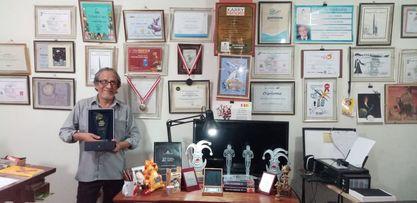
Karry
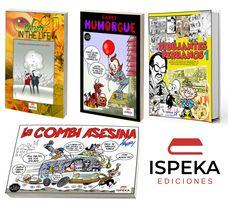
Editorial ISPEKA
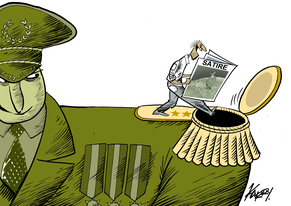
Militar
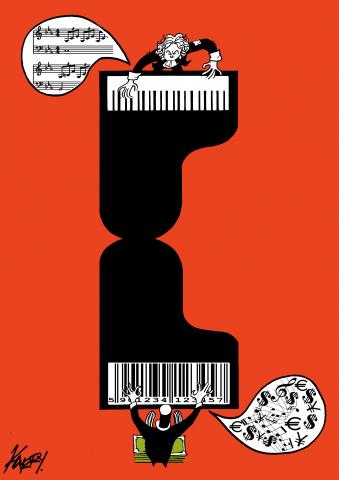
Beethoven comercial
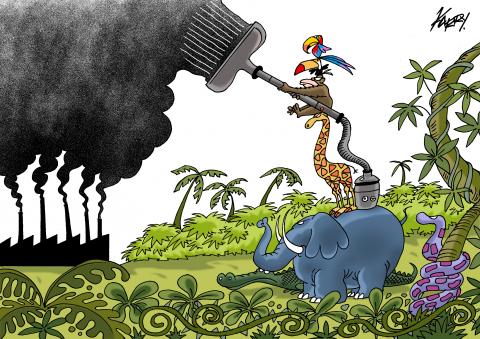
Smog
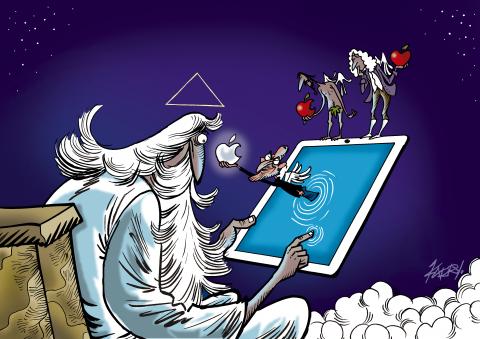
Steve Jobs
Hambre
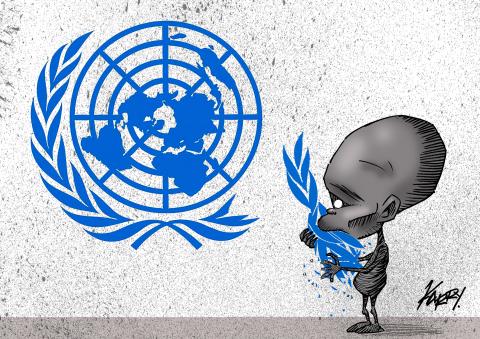
Hambre ONU
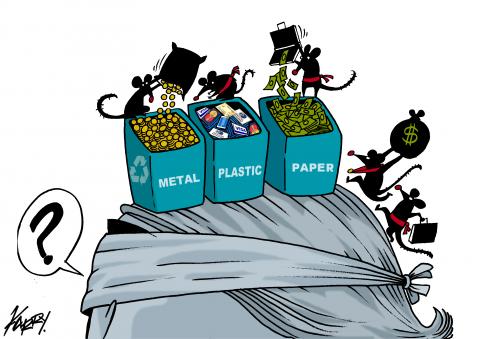
Corrupción inglesa
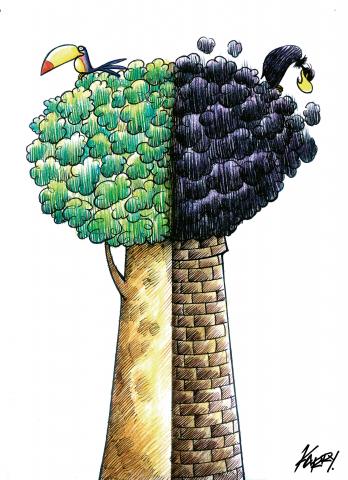
Chimenea
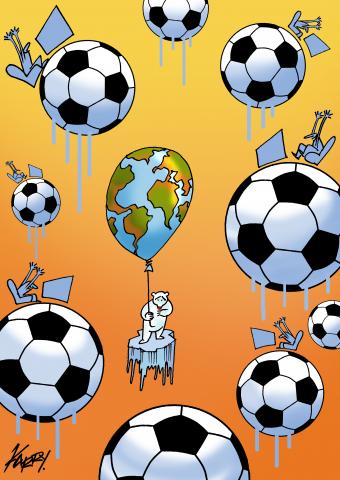
Calentamiento
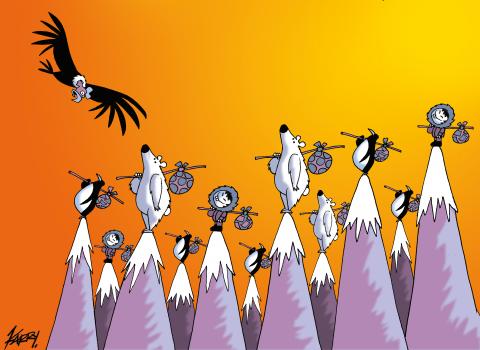
Cambio climático
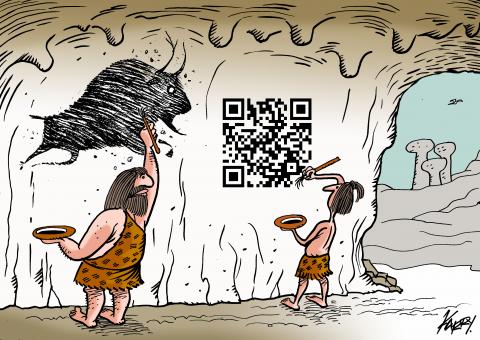
Código
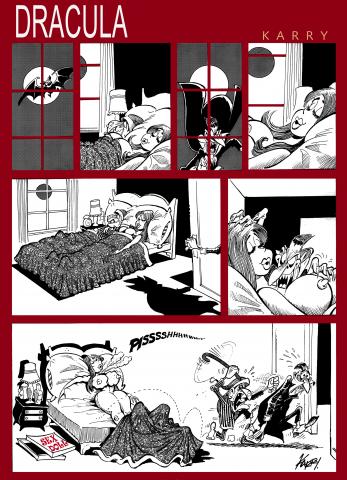
Draculada
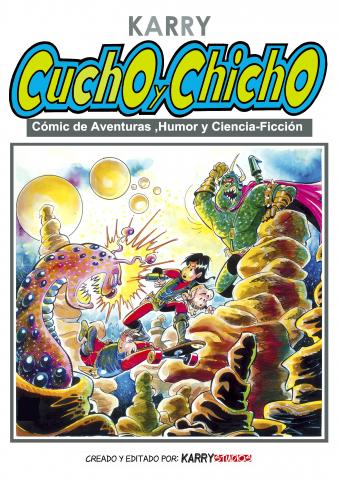
Comic Karry
Interview with Karry Carrión
By Pepe Pelayo
I adore the loose, spontaneous, human and imperfect stroke as my own life
Peru fascinates me because of: Machu Pichu, Cuzco, the Inca Trail, the jungle, its great pre-Columbian history, Colonial Lima, its little waltzes, its literature, its gastronomy! And of course, its people. But it was not because of any of the above that I chose this artist to "talk" today. I did it because of his talent, his sense of humor, his personality, his humility, simplicity and his sincere friendship. I confess that I feel tremendous pleasure and pride in interviewing the multi-award-winning Peruvian cartoonist, Karry Carrión.
And without further introduction, let's move on to the questions...
PP: Dear friend, can you introduce yourself, in case there is a Humor Sapiens reader who doesn't know you?
KARRY: I'm a cartoonist, cartoonist, and cultural manager. I was born in Lima, Peru. The love for art and classical music is because of my father. The mischief, the humor, the joda, for my mother. I became independent at the age of 19. It was impossible for me to study in an art school. I learned alone and enclosed between humor books and comics magazines, submerged in the search and discovery of my passion for graphic humor, for comics. I'm autodidactic. My best school was to publish and publish without stopping in the most popular media with high readership. Since the 80s I have published in 15 newspapers and humor magazines, under the pseudonyms: “Carr”, “Carrión”, “Julán”. There were times when circumstances forced me to draw for 4 newspapers at the same time with different signatures and styles. I enjoyed that blessed madness!
In the 90s "Karry" was born for Peru and the world. Thanks to the most emblematic comic strips of my graphic history: "Simeón" and "La Combi Asesina", I achieved a certain celebrity and a determined position in this difficult market, managing two languages: one universal (without words) and another localist popular language ( with texts).
I adore the loose, spontaneous, human and imperfect line like my own life. I have fun looking for irony in situations, to provoke, excite, denounce, reflect or just have fun.
Since 2005 I have been awarded more than 80 national and international prizes. I have edited more than 15 of my own publications. In 2021 I worked for Red Bull and for UNESCO-France. I am director of the satirical Quarterly magazine "Monaliza".
The family goes hand in hand. My wife is a great ally. She also makes art and we started the Karry Studios school of humor and caricature together. To energize and disseminate the art of humor and caricature, we formed and created the artistic collective "Mochi Comic". For a change, I run the publishing house ISPEKA EDICIONES. I move a lot at Fairs, I love the adrenaline of artistic activations. I made humor a way of life and a profession.
PP: Excellent self portrait, Karry. If the goal was to meet you, we can already end the interview here, ha ha. But not. I want our readers to know more about you, beyond your autobiography. For example: have you varied, have you evolved, your way of making humor, from your beginnings to this moment?
KARRY: I suspect so, brother. If before I did everything quickly, instinctively, now I think more about changes in concepts, both in form and content.
Starting in 2005, my powerful Haikus of art and humor crossed borders, they began to obtain prizes and recognitions. I began to receive invitations as a jury to international competitions. As well as I was invited in several international collective exhibitions. All of that nourishes, my friend.
I suspect there was an evolution. To illustrate, I highlight a comment published in one of my books. I am referring to the words of the teacher Juan Acevedo, one of the most important scholars of Peruvian humor and comics, who sums it all up in one: Karry is a very peculiar cartoonist, who has been able to draw on the humor of our streets and elevate it. to a universal dimension, uniting the popular and elitist sap.
PP: I have no doubts about that, brother. But I would like to know: do you think you have a definite, clear influence from living or historical colleagues?
KARRY: My first influence would be my father. Color, art, was already in my DNA. My father, "Julkar", was a surrealist painter, graduated from the School of Fine Arts. A madman of the forms and the absurd.
Starting in 2005, my powerful Haikus of art and humor crossed borders, they began to obtain prizes and recognitions. I began to receive invitations as a jury to international competitions. As well as I was invited in several international collective exhibitions. All of that nourishes, my friend.
I suspect there was an evolution. To illustrate, I highlight a comment published in one of my books. I am referring to the words of the teacher Juan Acevedo, one of the most important scholars of Peruvian humor and comics, who sums it all up in one: Karry is a very peculiar cartoonist, who has been able to draw on the humor of our streets and elevate it. to a universal dimension, uniting the popular and elitist sap.
PP: I have no doubts about that, brother. But I would like to know: do you think you have a definite, clear influence from living or historical colleagues?
KARRY: My first influence would be my father. Color, art, was already in my DNA. My father, "Julkar", was a surrealist painter, graduated from the School of Fine Arts. A madman of the forms and the absurd.
I tell you that in the 80s I got into the wave of being a humor cartoonist, of children's adventures. I wanted to be a Uderzo, a Willy Eisner, but one of Peruvian legends, like my compatriots Crose or Hernán Bartra.
Then in the 90s, my references were: Quino, Mordillo, Caloi, Sempé, Steiberg, Palomo...
When I decided to dedicate myself entirely to graphic humor, some colleagues said that Peru lost a great comic adventure cartoonist. hehehehee… Which I don't believe!
PP: Well, I do. So, do you feel happy and fulfilled with your career in humor, with so many awards? How does it feel to know that you are one of the most renowned Peruvian cartoonists of all time? (I know you and I know you're not arrogant or self-sufficient, but don't be too modest now either, please.)
KARRY: I am not going to deny that I am happy and very honored to transcend with my humorous cartoons in the world. I have always had the ego behind my work. The prizes are not for me but for my cartoons, which are the consequences of a successful process in ideas and drawing. The fact of being chosen among thousands of cartoons by an international jury is exciting. But the richest thing is the hug from family and colleagues when you win an important one. Over the years I understood that when you really love something and give it all your time and dedication, as if it were your girlfriend, in the end you are reciprocated.
PP: Your wife must be jealous of this girlfriend, right? Of course not. You already told me that he always accompanies you in your "follies" and also, he is an artist too. But I continue. Look, you've specialized in editorial cartoons and general humor. Which is more difficult for you to do? Which of them do you enjoy the most in your creation? What are the differences between the two?
KARRY: My graphic production is based on two pillars: silent humor and humor with text. I've heard it said that making silent humor is more difficult, because it's easy for me. I enjoy the freedom of generating humor without words in all its genres, I have more fun. Especially for contests, I explore, I change styles, concepts, I play a lot with the visually absurd.
On the other hand, with the editorial cartoons of everyday life, I feel typecast, I self-censor for adjusting to the journalistic context. I touch on all current socio-political issues. There are many years within national journalism reflecting the time. Since the 80s, imagine. Currently published in the "Trome", the best-selling newspaper in Latin America. That is why you have to think carefully about what you are going to think. My column has to connect with people and it works for me, because I know the language and codes of the most popular neighborhoods. From a very young age I was a “dog leg”, I was born in a very Creole neighborhood of Lima: “El palomar”. People with a lot of spark, jargon and all their "recuteco" of national flavor. The streets made me comedian.
The difference is that editorial cartoons have an expiration date, when the news dies, the joke dies. While general and timeless Humor lasts forever!
PP: I confess that I loved reading the word “recuteco”. I did not know that Peruvianism. I "googled" it and saw that it was: "individual who has street experience, corner, life experience". best and worst moment in your career in humor?
KARRY: The best moment was crossing borders and publishing on specialized platforms such as “Cartooning for Peace” (France), in “Cartoon Movemente” (Netherlands), “Toonpool.com” (Germany), “Club de la caricature Latina” ( Mexico) and be a representative of Peru, invited by the Union of World Cartoonist (Turkey).
The worst moments were the censorship in 2006 and 2007. I had to resign from a newspaper where I had worked since the 90s.
I tell you that it had a “Karrycaturas” section, for general humor. Several of those cartoons were awarded years later. But, unfortunately, they changed the director and they asked me… that my section “Karrycaturas” be political!
Well, I changed course and drew my pen criticizing the current government, that of Alan García. And what had to happen happened. The editors were supporters of that government and assured me that they would only publish “flannel humor” against the Aprista government. It was a myopic decision of the director at the time. I had to leave the newspaper, which was like my family. They gave me everything to develop my own language for 18 years. Eternally grateful to the owners. This is where the pseudonym “Karry” was born.
PP: I'm glad for your good moments, but those extra artistic things that hinder our paths as creators annoy me. But now I am going with several questions in one: how do you see the health of graphic humor today? Are there enough spaces to post? Is what is published almost always of good quality? Do you see much difference between the humor created for the contests and the rest? Is there enough consumer public?
KARRY: Unfortunately, there are few spaces in the print media to thrive and thrive on humor. But we have the wonder of the internet, especially for new talents, where they can show themselves without restrictions. Of course, not always what is seen is good. Some lack the trade that the years give. Social networks have helped a lot to make graphic humor more visible. But charging and living for what you upload to your networks is still the endless puzzle.
The humor for the contests has to have a hundred percent originality and great bill, while an editorial vignette is treated differently, but without losing quality. Publishers can't be that blind. We are in a totally visual era, they must recognize the function of humor as a catalyst for our society, and that it regain that prominence that it always had. It would be great if new publications appear to capture new generations of consumers.
PP: Agreed on everything, brother. Now, do we have a lot of censorship in the media and in the public these days? Lots of self-censorship? And to use the fashionable question: what are the limits of humor?
KARRY: My dear friend, When the word FREEDOM is spoken too loud it becomes a subversive cry, making political cartoons comes with great responsibility.
We are in a world where false moralists, trolls who, through their haters, rise up offended when you caricature their corrupt leader, asking for the author's head on a tray from the editors of print or digital media.
They say that political cartoons were born with democracy, but it's a lie. Publishers who support us should be more courageous in confronting bigotry and not silence our graphic opinions.
There are sensitive issues that can be touched.
PP: Now I will change you to a subject more of form than of content: do you think that the personal caricature, the editorial cartoon, the so-called caricature or humorous caricature in general, the comic strip, the comic, humorous photography (and its modalities within it), etc., are forms that are contained within the "graphic humor"? Or some do not fall within that concept?
KARRY: Visual communication is undoubtedly at the center of graphic humor. Any modality or form that helps to translate that humorous idea and manages to communicate, connecting that convergence between the intelligence of the humorist and that of the viewer, is valid.
PP: I think I asked a longer question than your answer. I have to learn more about the art of interviewing. Anyway, let's get back to our thing. Look, we know that the ideal work of graphic humor is the one that shows a perfect invoice and content that makes us smile and think. But often we see a magnificent idea expressed with a poor execution and vice versa, an impeccable work in terms of form, but with a weak idea. Which of these last two variants do you accept better? Or none or them? Because? (I fell back into the same thing: very long question. I hope you don't answer briefly).
KARRY: For me the IDEA is the essence. If the message is powerful, obviously it has to be accompanied by a visual force, accompanied by the appropriate technique to be read and interpreted by all.
PP: Even shorter answer! Ha ha, I have to retire. But don't worry about it, brother. You're fine, I'm just kidding... Dear friend, an important moment has come for you, I know. I want you to tell me about your new project, the one to which you have decided to dedicate yourself body and soul. Please tell me: what is it? How did you come up with that? What have you done already? What are your goals? Finally, tell us everything. And I hope you give us some scoop.
KARRY: On July 12, 2022, we met Martin Isla, cartoonist, researcher, compiler, collector, author of the blog "Mundo Comics", specializing in themes and authors of the Peruvian Comics. Also Javier Peralta, editor, printer, director of the magazine "Conexión" and Karry Carrión. That day we created ISPEKA EDICIONES, a publishing house that was born with the sole intention of remembering, revaluing and supporting Peruvian Comics. An editorial dedicated to rescuing the works of the Peruvian cartoonists and humorists of the 20th century, since no other editorial has taken the interest in highlighting the works of the Great Masters. The current publishers only fill their pockets by inflating and exploiting young cartoonists, more enthusiastic than professional.
Our objective is to put on the table the artistic legacy of those who preceded us and opened the path of humor and the Peruvian Cartoon, so that our new generations can know them and know how to be proud of what is ours.
As the director of ISPEKA, I can say that this project has a commitment and a life promise: to spread part of the immense legacy of endearing teachers, of colleagues and friends who worked side by side with this little chest.
Our first book was "Peruvian Cartoonists 1". Later would come "La Combi Asesina", "Humorgue" and the first graphic anthology book "Nebver in the life", by the master Nebver Sanmartín.
To begin with, I think that editing four titles in four months is enough.
The scoop is that by February we will already be presenting "Peruvian Cartoonists 2" in style. More than 100 pages in full color. The first was a complete success. And in September, if all goes well, another 200-page graphic anthology would come out, by the greatest Peruvian humorist of all time. crose.
Share the nostalgia of his Creole humor that accompanied us on Sundays in the 60s, 70s and 80s: "Domingueando con Crose".
PP: I congratulate you, brother. It is a very beautiful project. It is a wonderful contribution to Peruvian, Latin American and world humor. It goes without saying that I wish you the greatest success with that. And how much with me and with Humor Sapiens to help in whatever. But to close this "dialogue", within humor, what would you like to do that you haven't done? (It can even be to dabble in other modalities).
KARRY: I always wanted to be a comedian. But I don't have the capacity that you have. So I made a comedy out of my life. I spent acting and laughing at myself, heh, hehehehe.
PP: Excuse me, but I think you can act. In everyday life you are very passionate, outgoing. It seems to me that it would be easy for you to do comedy on stage. Try to see. I wouldn't be surprised if you were also tremendously successful… And as a last question, are there any questions that I haven't asked you that you wish I had? If so, can you answer it now?
KARRY: Yeah, sure. The question would be: are there new generations that make graphic humor in Peru?
And I answer it worried: a bleak horizon is shaping up for Peruvian graphic humor.
Behind our generation that is leaving, there is a void. There are no future generations, I don't see high-profile comedians in my country. I don't see anyone under 30 listed. The majority of young people dabble in and stay in comics. We are still in force in the media the same as always. For half a century they have still maintained the same quality, some have even evolved. That does not mean that the ten professionals that exist have to leave, to make way for young people. What happens is that there are no new proposals and that is sad. But I see a little light in international competitions. And I've checked about five new names. There is no more, unfortunately.
Dear PP, I am immensely grateful for your interview and your great complicity in these paths of humor. I hope my words can contribute something to your widely read and famous Humor Bulletin.
Hug KARRYfunny!
PP: No, brother, the grateful one is me. I know that you are very complicated at work and personally, so devoting so much time and brain cells to me was an effort for you and, I repeat, I thank you from the bottom of my heart.
And that you contributed, do not doubt it. I confess that if our Newsletter and our website is as widely read and famous as you say, it is precisely because of the contribution of the great Masters of Humor, of great friends like you.
Hug Karrybeño!
(This text has been translated into English by Google Translate)

